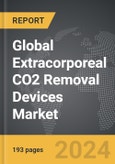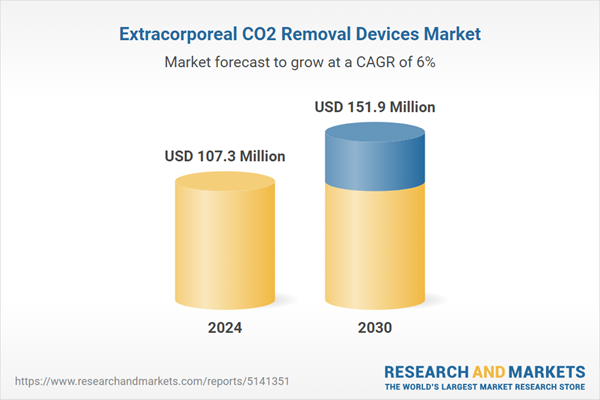Global Extracorporeal CO2 Removal Devices Market - Key Trends & Drivers Summarized
Why Are Extracorporeal CO2 Removal Devices Critical for Respiratory Care?
Extracorporeal CO2 removal (ECCO2R) devices have become vital in the management of severe respiratory conditions, offering a less invasive alternative to traditional ventilation. ECCO2R devices function by removing carbon dioxide (CO2) from the patient's blood externally, providing relief for patients with chronic obstructive pulmonary disease (COPD), acute respiratory distress syndrome (ARDS), and other lung disorders where CO2 accumulation is a critical concern. These devices are particularly beneficial in managing severe cases without the need for high-pressure mechanical ventilation, which can cause further lung injury. By reducing CO2 levels, ECCO2R devices help stabilize respiratory functions, allowing the lungs to rest and recover. The development of portable and user-friendly versions of these devices is also expanding their use beyond intensive care units, making them a promising solution for chronic respiratory management.How Are Technological Advancements Shaping the ECCO2R Market?
With continuous advancements in medical technology, ECCO2R devices are becoming more efficient, compact, and adaptable to various patient needs. Innovations include integrating biocompatible materials that minimize complications and infections, and the use of advanced monitoring systems that ensure precise CO2 removal tailored to each patient's specific condition. The trend toward minimally invasive approaches in healthcare has also led to the design of ECCO2R devices that are less intrusive, enabling quicker setup and easier integration into existing respiratory support systems. Additionally, companies are focusing on developing portable devices that offer greater flexibility for both in-hospital and home care settings, opening new avenues for chronic condition management. These advancements are making ECCO2R devices a pivotal component in the management of respiratory diseases, enhancing patient outcomes while reducing healthcare costs.What Are the Emerging Applications and Trends in ECCO2R Devices?
The market for ECCO2R devices is expanding as their applications extend beyond traditional hospital settings. With increasing incidences of chronic respiratory diseases globally, these devices are now being explored for long-term management solutions, especially in outpatient and home-care environments. Medical practitioners are increasingly adopting ECCO2R devices for critical care scenarios where traditional methods might be ineffective or pose risks of complications. Furthermore, the COVID-19 pandemic has highlighted the need for effective respiratory support devices, boosting the research and development efforts towards improving ECCO2R efficiency and accessibility. The growing emphasis on patient mobility and comfort is also pushing manufacturers to innovate, producing lighter and more versatile devices that can be used in diverse care settings, including emergency response units and field hospitals.What Factors Are Fueling the Growth of the ECCO2R Market?
The growth in the ECCO2R market is driven by several factors, including the increasing prevalence of respiratory diseases such as COPD and ARDS, which demand effective CO2 management solutions. The impact of the COVID-19 pandemic has also underscored the necessity for advanced respiratory support technologies, further stimulating demand. Additionally, technological innovations, such as the development of biocompatible and minimally invasive ECCO2R devices, are enhancing the adoption of these systems in various healthcare settings. The push towards portable and home-care respiratory solutions, fueled by patient preference and the need for healthcare cost reduction, is further accelerating the market's growth. Rising investments in healthcare infrastructure and respiratory device innovation, particularly in emerging markets, are expected to create significant growth opportunities in the ECCO2R sector.Report Scope
The report analyzes the Extracorporeal CO2 Removal Devices market, presented in terms of market value (US$ Thousand). The analysis covers the key segments and geographic regions outlined below.- Segments: Product (Extracorporeal CO2 Machines, Disposables, Other Products); Access (Venovenous, Arteriovenous); Application (Bridge To Lung Transplant, Acute Respiratory Distress Syndrome (ARDS), Chronic Obstructive Pulmonary Disease (COPD), Other Applications); End-Use (Hospitals, Ambulatory Surgery Centers, Clinics, Other End-Uses).
- Geographic Regions/Countries:World; United States; Canada; Japan; China; Europe (France; Germany; Italy; United Kingdom; and Rest of Europe); Asia-Pacific; Rest of World.
Key Insights:
- Market Growth: Understand the significant growth trajectory of the Extracorporeal CO2 Machines segment, which is expected to reach US$89.9 Million by 2030 with a CAGR of a 6.6%. The Disposables segment is also set to grow at 5.4% CAGR over the analysis period.
- Regional Analysis: Gain insights into the U.S. market, valued at $29.4 Million in 2024, and China, forecasted to grow at an impressive 5.5% CAGR to reach $23.6 Million by 2030. Discover growth trends in other key regions, including Japan, Canada, Germany, and the Asia-Pacific.
Why You Should Buy This Report:
- Detailed Market Analysis: Access a thorough analysis of the Global Extracorporeal CO2 Removal Devices Market, covering all major geographic regions and market segments.
- Competitive Insights: Get an overview of the competitive landscape, including the market presence of major players across different geographies.
- Future Trends and Drivers: Understand the key trends and drivers shaping the future of the Global Extracorporeal CO2 Removal Devices Market.
- Actionable Insights: Benefit from actionable insights that can help you identify new revenue opportunities and make strategic business decisions.
Key Questions Answered:
- How is the Global Extracorporeal CO2 Removal Devices Market expected to evolve by 2030?
- What are the main drivers and restraints affecting the market?
- Which market segments will grow the most over the forecast period?
- How will market shares for different regions and segments change by 2030?
- Who are the leading players in the market, and what are their prospects?
Report Features:
- Comprehensive Market Data: Independent analysis of annual sales and market forecasts in US$ Million from 2024 to 2030.
- In-Depth Regional Analysis: Detailed insights into key markets, including the U.S., China, Japan, Canada, Europe, Asia-Pacific, Latin America, Middle East, and Africa.
- Company Profiles: Coverage of players such as Aferetica Srl, Alung Technologies, Inc., ESTOR S.P.A, Getinge AB, Medica SpA and more.
- Complimentary Updates: Receive free report updates for one year to keep you informed of the latest market developments.
Some of the 44 companies featured in this Extracorporeal CO2 Removal Devices market report include:
- Aferetica Srl
- Alung Technologies, Inc.
- ESTOR S.P.A
- Getinge AB
- Medica SpA
- Medtronic PLC
- Xenios AG
This edition integrates the latest global trade and economic shifts into comprehensive market analysis. Key updates include:
- Tariff and Trade Impact: Insights into global tariff negotiations across 180+ countries, with analysis of supply chain turbulence, sourcing disruptions, and geographic realignment. Special focus on 2025 as a pivotal year for trade tensions, including updated perspectives on the Trump-era tariffs.
- Adjusted Forecasts and Analytics: Revised global and regional market forecasts through 2030, incorporating tariff effects, economic uncertainty, and structural changes in globalization. Includes historical analysis from 2015 to 2023.
- Strategic Market Dynamics: Evaluation of revised market prospects, regional outlooks, and key economic indicators such as population and urbanization trends.
- Innovation & Technology Trends: Latest developments in product and process innovation, emerging technologies, and key industry drivers shaping the competitive landscape.
- Competitive Intelligence: Updated global market share estimates for 2025, competitive positioning of major players (Strong/Active/Niche/Trivial), and refined focus on leading global brands and core players.
- Expert Insight & Commentary: Strategic analysis from economists, trade experts, and domain specialists to contextualize market shifts and identify emerging opportunities.
Table of Contents
Companies Mentioned (Partial List)
A selection of companies mentioned in this report includes, but is not limited to:
- Aferetica Srl
- Alung Technologies, Inc.
- ESTOR S.P.A
- Getinge AB
- Medica SpA
- Medtronic PLC
- Xenios AG
Table Information
| Report Attribute | Details |
|---|---|
| No. of Pages | 193 |
| Published | December 2025 |
| Forecast Period | 2024 - 2030 |
| Estimated Market Value ( USD | $ 107.3 Million |
| Forecasted Market Value ( USD | $ 151.9 Million |
| Compound Annual Growth Rate | 6.0% |
| Regions Covered | Global |









